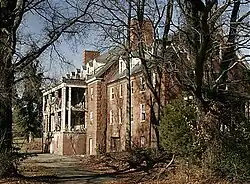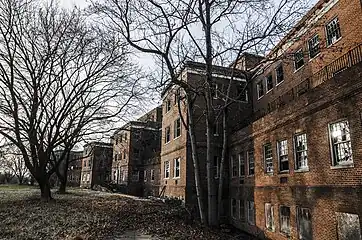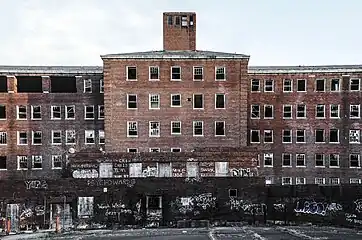| Glenn Dale Hospital | |
|---|---|
| Geography | |
| Location | Glenn Dale, Maryland, United States |
| Organization | |
| Type | Specialist |
| Services | |
| Speciality | Tuberculosis hospital and Sanatorium |
| History | |
| Opened | after 1934 |
| Closed | 1981 |
| Links | |
| Lists | Hospitals in Maryland |
Glenn Dale Tuberculosis Hospital and Sanatorium | |
 The Glenn Dale Hospital | |
  | |
| Location | 5201 Glenn Dale Rd., Glenn Dale, Maryland |
| Coordinates | 38°57′39″N 76°48′48″W / 38.96083°N 76.81333°W |
| Area | 206.11 acres (0.8341 km2) |
| Built | 1934 |
| Architect | Albert L. Harris; Nathan C. Wyeth; Lawrence Johnston; Merrel C. Coe[1] |
| Architectural style | Colonial Revival |
| NRHP reference No. | 11000822[2] |
| Added to NRHP | November 18, 2011 |
Glenn Dale Hospital was a tuberculosis sanatorium and isolation hospital in Glenn Dale, Maryland, in the United States. It is a large facility, consisting of 23 buildings on 216 acres (87 ha), that was built in 1934 and closed in 1981 due to asbestos.[1]
Though it is now closed and may be eventually demolished, for decades it was an important public health institution near Washington, DC. The Maryland-National Capital Park and Planning Commission Park Police patrol the hospital grounds regularly.
Grounds
The hospital grounds consist of several buildings:
- Children's Nurses' Home
- Children's Hospital Building
- Residence "D" Dormitory
- Building "C" Nurses' Home
- Building "F" Duplex House
- Building "D" Doctor's House
- Building "G" Duplex House (Superintendent's Residence)
- Building "E" Doctor's House
- Adult Hospital Building
- Warehouse and Mechanics Garage
- Heating and Power Plant
- Sludge Bed Enclosure
- Sedimentation and Control Building
- Water Softener House
- Pump House
- Employee Building
- Laundry
- Residence "C" Dormitory
- Hot House
- Four Apartment Building No. 1
- Four Apartment Building No. 2
- Paint and Repair Shop
- Incinerator
Other parts of the hospital include: art rooms, staff housing, nurses' homes, playgrounds, theater, seclusion rooms, storage areas, chapels, morgues, and boiler rooms.
The buildings are characterized by broken glass, peeling paint, corroded walls and overgrown vines. Several of the buildings also have collapsed roofs.

The children's hospital building and adult hospital building are the most widely explored structures by local trespassers. This is primarily due to their close distance to Glenn Dale Road, a local street that bisects the hospital grounds.
Contrary to popular belief, the large incinerator present on the hospital grounds was not used for the destruction of human remains. Instead, hospital waste was burned.
Both the children's and adults' buildings are connected by a series of tunnels, like many sanitariums. These walkways join the basements of both buildings together. The basements of the hospital buildings are extremely dangerous and filthy. Large pieces of rusty, sharp metal, cloth and debris hang from the ceiling, and the buildings contain large amounts of asbestos and lead paint. Each hospital basement has its own morgue. Today, these walkways are littered with garbage, broken glass, and graffiti. The hospital basements are also infested with rats and bats. In addition, parts of the walkways are flooded with nearly 3 feet (0.91 m) of water.
Proposed sale
In 1994, Maryland enacted a law that requires if the grounds are sold, they are supposed to be used as a continuing care retirement community. The rest of the land is meant to be open space park land. In 1995, the Maryland-National Capital Park and Planning Commission (MNCPPC) purchased the property from the District of Columbia. Under the deed, if the MNCPPC receives more than its cost from selling the property, it must share the proceeds with the District.
In June 2010, MNCPPC advertised for proposals to purchase the 60-acre (240,000 m2) hospital campus "as is" with the MNCPPC retaining the surrounding 150 acres (0.61 km2). Final bids were due on September 14, 2010, but that deadline was extended to October 15, 2010.[3][4] Ultimately, two bids were received,[5] but the MNCPPC rejected both bids on the basis that neither bidder was licensed to operate a continuing care retirement community.[6] In the meantime, the Countywide Historic Preservation Staff of MNCPPC is preparing an application to designate the hospital on the National Register of Historic Places, which would make tax credits available for restoration.[7] It was listed on the National Register of Historic Places in November 2011.[2] In 2014, Preservation Maryland placed the Glenn Dale Hospital on its list of threatened historic properties.[8]
"Quarantined"
The hospital was featured in an award-winning Washington Post Magazine article, "Quarantined," on Dec. 10, 2006 by Leah Y. Latimer, former staff writer and author. The article detailed Latimer's mother's hospitalization there in the 1950s and the emotional fall-out for their family from then to the present. Latimer gave a lecture on the actual grounds of Glenn Dale on October 4, 2008. It was the first time the public was allowed on the grounds in almost 30 years. The unadvertised event drew more than 150 people.[9]
Gallery
 The back of the Children's Hospital Building.
The back of the Children's Hospital Building..JPG.webp) Side view of the back of the Adult Hospital Building
Side view of the back of the Adult Hospital Building The back of the Adult Hospital Building
The back of the Adult Hospital Building
References
- 1 2 Emma K. Young (October 2009). "National Register of Historic Places Registration: Glenn Dale Tuberculosis Hospital and Sanatorium" (PDF). Maryland Historical Trust. Retrieved 2015-08-01. Includes 38 photos from 2009.
- 1 2 "National Register of Historic Places Listings". Weekly List of Actions Taken on Properties: 11/14/11 through 11/18/11. National Park Service. 2011-11-25.
- ↑ Wiggins, Ovetta (September 9, 2010). "For sale: Glenn Dale - 'as is'". Washington Post. p. B1.
- ↑ Wiggins, Ovetta (September 19, 2010). "Bids extended for Glenn Dale Hospital". Washington Post. p. C3.
- ↑ Wiggins, Ovetta (October 19, 2010). "2 companies bid on Glenn Dale". Washington Post. p. B5.
- ↑ Skalsk, Liz (November 5, 2010). "Park and Planning rejects bids for Glenn Dale Hospital site". Prince Georges Gazette. Retrieved 2010-11-10.
- ↑ Skalski, Liz (October 21, 2010). "Owner of Glenn Dale Hospital goes after historic designation". Washington Post. Retrieved 2010-11-10.
- ↑ "Endangered Maryland". Preservation Maryland. Retrieved 24 June 2015.
- ↑ Latimer, Leah Y. (2006-12-10). "Quarantined". Washington Post. Retrieved 19 March 2014.
External links
- Glenn Dale hospital photos and history
- Pictures, maps and detailed information
- Weird U.S.: Glenn Dale Hospital at the Wayback Machine (archived August 28, 2008)
- Glenn Dale Redevelopment Project
- Glenn Dale Tuberculosis Hospital and Sanatorium, Prince George's County, Inventory No.: PG:70-50, including undated photo, at Maryland Historical Trust website

